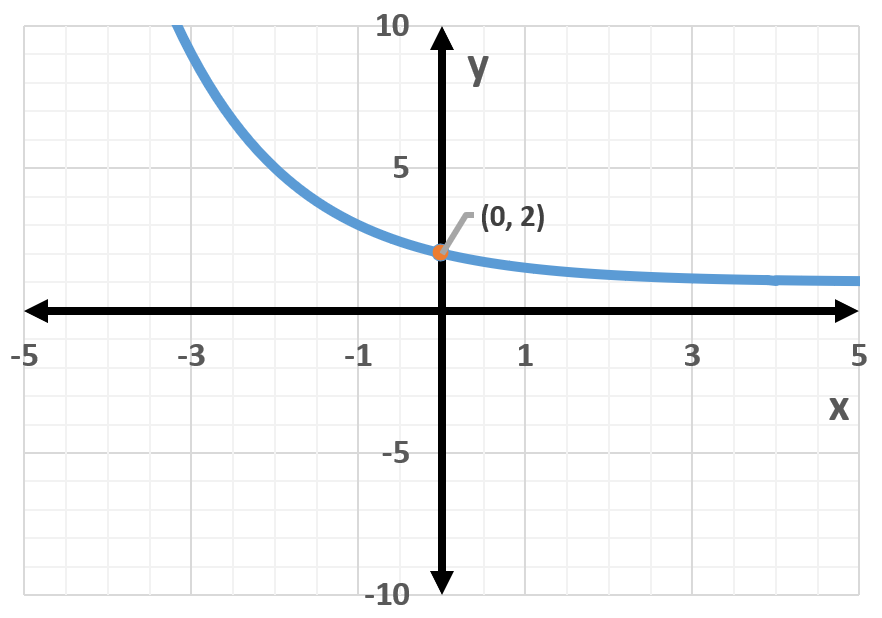Ch. 4 - Exponential and Logarithmic Functions
 Back
Back- In Exercises 1–4, the graph of an exponential function is given. Select the function for each graph from the following options: f(x) = 4^x, g(x) = 4^-x, h(x) = -4^(-x), r(x) = -4^(-x)+3 1.
Problem 1

- In Exercises 1–10, approximate each number using a calculator. Round your answer to three decimal places. 2^3.4
Problem 1
- In Exercises 1–8, write each equation in its equivalent exponential form. 4 = log₂ 16
Problem 1
- In Exercises 1–40, use properties of logarithms to expand each logarithmic expression as much as possible. Where possible, evaluate logarithmic expressions without using a calculator. log5 (7 × 3)
Problem 1
- Solve each exponential equation in Exercises 1–22 by expressing each side as a power of the same base and then equating exponents. 2^x=64
Problem 1
- In Exercises 1–4, the graph of an exponential function is given. Select the function for each graph from the following options: f(x) = 4^x, g(x) = 4^-x, h(x) = -4^(-x), r(x) = -4^(-x)+3 3.
Problem 3

- Solve each exponential equation in Exercises 1–22 by expressing each side as a power of the same base and then equating exponents. 5^x=125
Problem 3
- In Exercises 1–10, approximate each number using a calculator. Round your answer to three decimal places. 3^√5
Problem 3
- In Exercises 1–8, write each equation in its equivalent exponential form. 2 = log3 x
Problem 3
- In Exercises 1–40, use properties of logarithms to expand each logarithmic expression as much as possible. Where possible, evaluate logarithmic expressions without using a calculator. log7 (7x)
Problem 3
- In Exercises 1–8, write each equation in its equivalent exponential form. 2 = log9 x
Problem 4
- Solve each exponential equation in Exercises 1–22 by expressing each side as a power of the same base and then equating exponents. 2^2x−1=32
Problem 5
- In Exercises 1–10, approximate each number using a calculator. Round your answer to three decimal places. 4^-1.5
Problem 5
- In Exercises 1–8, write each equation in its equivalent exponential form. 5= logb 32
Problem 5
- In Exercises 1–40, use properties of logarithms to expand each logarithmic expression as much as possible. Where possible, evaluate logarithmic expressions without using a calculator. log(1000x)
Problem 5
- In Exercises 5–9, graph f and g in the same rectangular coordinate system. Use transformations of the graph of f to obtain the graph of g. Graph and give equations of all asymptotes. Use the graphs to determine each function's domain and range. f(x) = 3^x and g(x) = -3^x
Problem 7
- Solve each exponential equation in Exercises 1–22 by expressing each side as a power of the same base and then equating exponents. 4^2x−1=64
Problem 7
- In Exercises 1–10, approximate each number using a calculator. Round your answer to three decimal places. e^2.3
Problem 7
- In Exercises 1–8, write each equation in its equivalent exponential form. log6 216 = y
Problem 7
- In Exercises 1–40, use properties of logarithms to expand each logarithmic expression as much as possible. Where possible, evaluate logarithmic expressions without using a calculator. log7 (7/x)
Problem 7
- In Exercises 5–9, graph f and g in the same rectangular coordinate system. Use transformations of the graph of f to obtain the graph of g. Graph and give equations of all asymptotes. Use the graphs to determine each function's domain and range. f(x) = e^x and g(x) = 2e^(x/2)
Problem 9
- Solve each exponential equation in Exercises 1–22 by expressing each side as a power of the same base and then equating exponents. 32^x=8
Problem 9
- In Exercises 1–10, approximate each number using a calculator. Round your answer to three decimal places. e^-0.95
Problem 9
- In Exercises 1–40, use properties of logarithms to expand each logarithmic expression as much as possible. Where possible, evaluate logarithmic expressions without using a calculator. log(x/100)
Problem 9
- Use the compound interest formulas to solve Exercises 10–11. Suppose that you have $5000 to invest. Which investment yields the greater return over 5 years: 1.5% compounded semiannually or 1.45% compounded monthly?
Problem 10
- In Exercises 9–20, write each equation in its equivalent logarithmic form. 5^4 = 625
Problem 10
- Solve each exponential equation in Exercises 1–22 by expressing each side as a power of the same base and then equating exponents. 9^x=27
Problem 11
- In Exercises 9–20, write each equation in its equivalent logarithmic form. 2^-4 = 1/16
Problem 11
- In Exercises 1–40, use properties of logarithms to expand each logarithmic expression as much as possible. Where possible, evaluate logarithmic expressions without using a calculator. log4 (64/y)
Problem 11
- In Exercises 11–18, graph each function by making a table of coordinates. If applicable, use a graphing utility to confirm your hand-drawn graph. f(x) = 4^x
Problem 11

